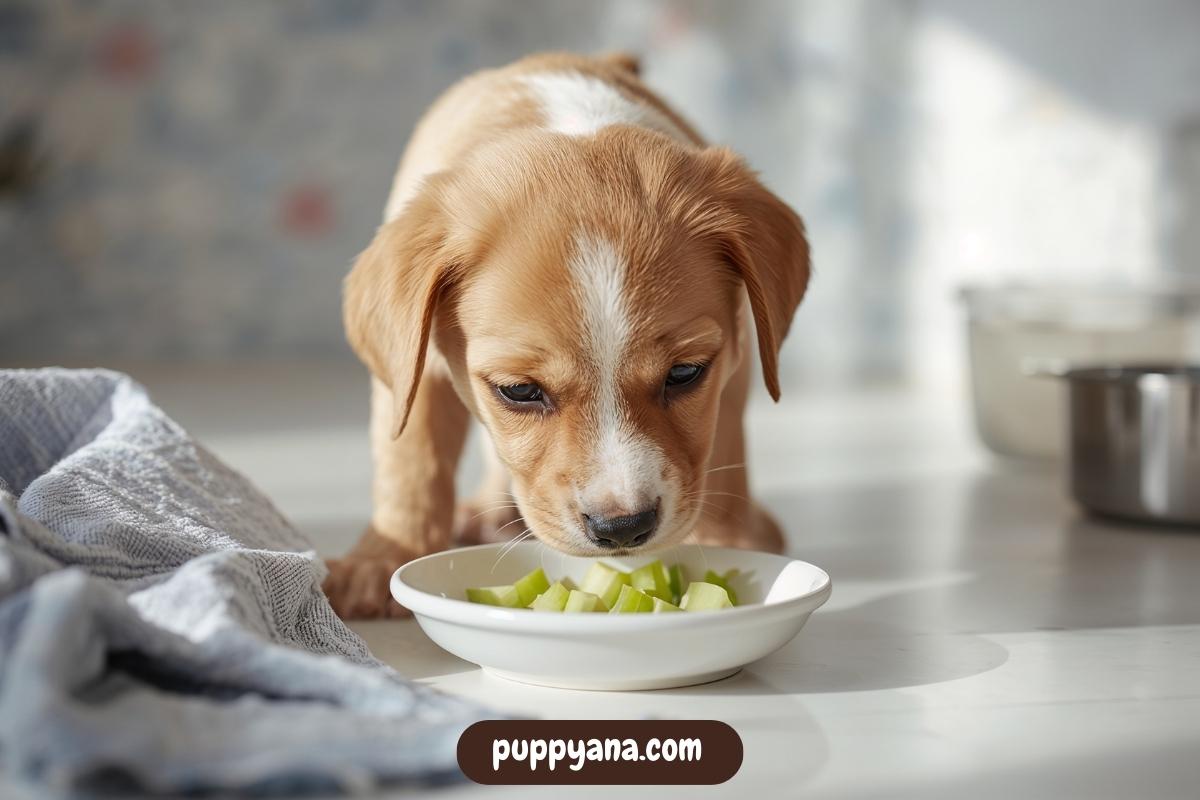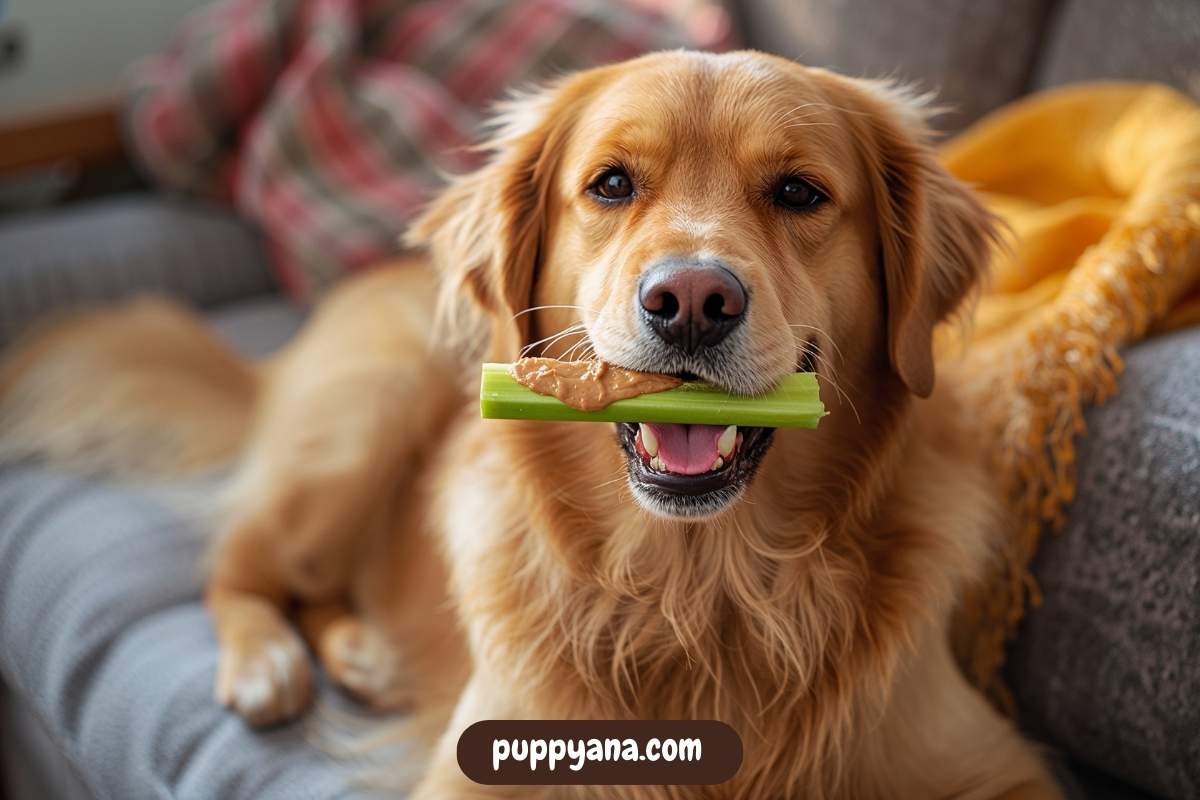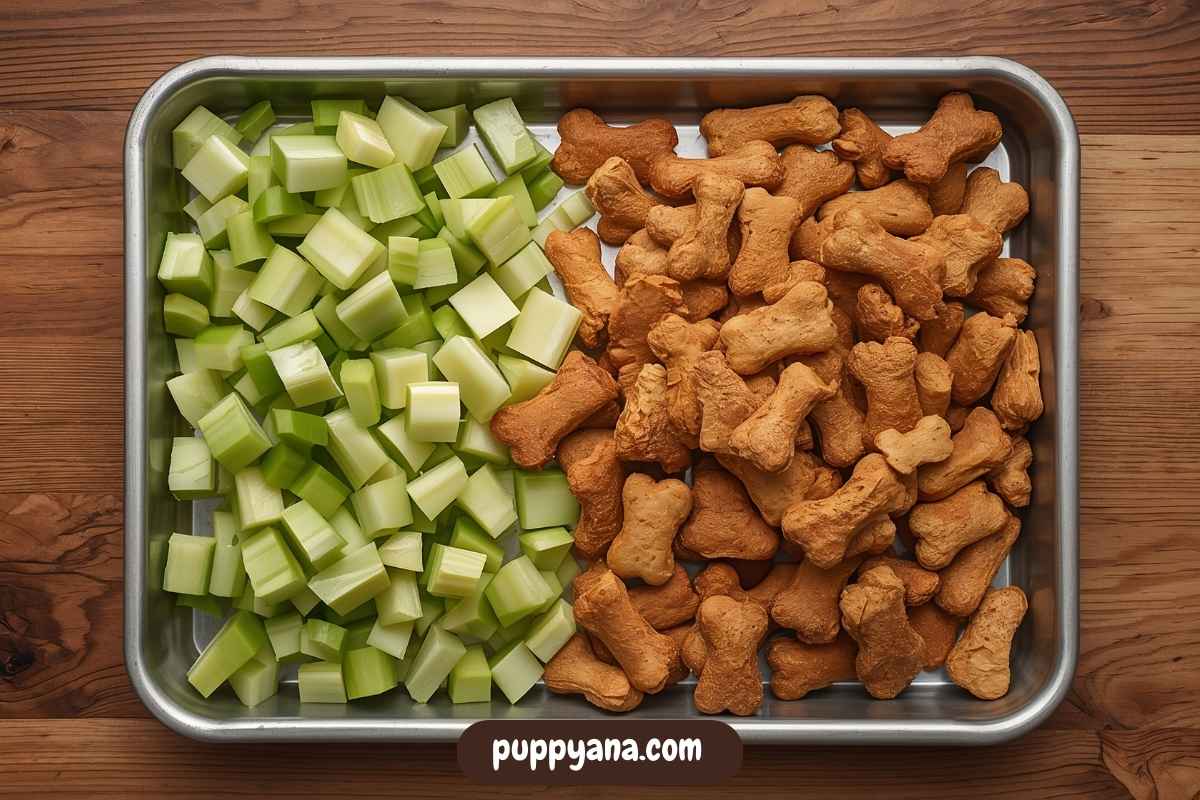When you’re slicing up crunchy sticks of celery to add to your salad or snack plate, it’s only a matter of time before your dog appears, tail wagging, eyes locked on each crisp piece. But before you toss a stalk their way, it’s worth asking: can dogs have celery, and is it actually good for them?
Celery is widely regarded as a low-calorie, high-water veggie that’s great for humans, but not all human foods are safe for dogs. In this comprehensive guide, we’ll break down whether celery is safe, the benefits and risks, and exactly how to prepare it for your four-legged family member.
Let’s dig in.

Table of Contents
ToggleCan Dogs Have Celery?
Yes. Dogs can have celery in moderation, and in many cases, it can even be a beneficial addition to their diet.
According to the American Kennel Club, celery is not toxic to dogs and can be offered as a treat from time to time. It contains fiber, vitamins, and a high-water content that can actually help keep your dog hydrated, especially during warmer months.
However, like any treat, celery should be introduced carefully and served in appropriate portions based on your dog’s size and dietary tolerance.
Nutritional Benefits of Celery for Dogs
If you’re looking for a light, guilt-free snack for your pup, plain celery might do the trick. It’s naturally low in fat, calories, and sugar—making it a smart treat choice, especially for dogs that need to lose a few pounds or stick to a low-calorie diet.
| Nutrient | Benefit for Dogs |
|---|---|
| Vitamin K | Helps maintain healthy blood clotting and bones |
| Vitamin A | Supports eye health and immune system function |
| Vitamin C | Acts as an antioxidant that supports immunity |
| Fiber | Aids digestive health and regular bowel movements |
| Water | Celery is 95% water, helping maintain hydration |
| Low-calorie | Great for dogs that need weight control snacks |
Because of its crunchy texture, celery can also help naturally clean your dog’s teeth as they chew, though it’s no replacement for regular brushing.

Risks of Feeding Celery to Dogs
Even though celery is safe for dogs, that doesn’t mean it’s without risk. Here’s what to watch for when introducing it to your pet’s diet:
1. Choking Hazard
Because celery is fibrous and stringy, larger pieces can be tough to chew, especially for small breeds. If not cut properly, it can pose a choking risk.
2. Digestive Upset
In some dogs, high-fiber snacks like celery might cause:
- Gas
- Loose stools
- Vomiting
This is usually harmless, but if symptoms persist, stop feeding celery and consult your vet.
3. Allergic Reactions (Rare)
Though uncommon, dogs can be allergic to vegetables. Symptoms of a food allergy include:
- Itchiness
- Ear inflammation
- Excessive licking
- Gastrointestinal issues
As always, when introducing a new food, it’s a good idea to offer a small portion and monitor closely for any negative reactions.
PetMD notes that while celery is generally safe, any new food can potentially trigger an allergic response depending on your dog’s unique sensitivities.
How to Prepare Celery for Dogs
Celery is safest (and tastiest for dogs) when served properly. Avoid raw stalks that are stringy and hard to chew, particularly for small dogs or puppies.
Best Prep Methods:
- Wash thoroughly: Always rinse celery under cold water to remove dirt, bacteria, or pesticides.
- Cut into bite-sized pieces: Slice thinly or into small sticks, depending on your dog’s size.
- Remove leaves: Though not toxic, celery leaves can have pesticide residues and aren’t necessary for your dog’s nutrition.
- Cooked celery (optional): Lightly steamed celery is easier to chew and digest.
Never add:
- Salt
- Garlic or onion powder
- Butter or seasoning blends
Stick to plain celery only. The ASPCA warns that common flavorings added to cooked vegetables, such as onion, garlic, and oils, can be dangerous or even toxic to pets.
How Much Celery Can Dogs Have?
Like any snack or treat, celery should be given in moderation, it should never replace a full meal or complete dog food.
Recommended Serving Sizes:
| Dog Size | Max Celery Per Day |
|---|---|
| Small (under 20 lbs) | 1–2 bite-sized pieces |
| Medium (20–50 lbs) | 2–3 small sticks |
| Large (50+ lbs) | 3–5 small sticks |
Celery should never exceed more than 10% of your dog’s daily caloric intake, which aligns with treat guidelines from veterinary nutritionists.
Can Puppies Have Celery?
Yes, but with even more caution.
Puppies have delicate digestive systems and small airways, so celery can become a choking hazard or cause loose stool more easily compared to adult dogs.
If you do offer celery to a curious puppy:
- Use soft, peeled stalks only
- Steam or blanch celery for better digestion
- Offer a piece no longer than a fingertip
- Supervise closely
According to PuppyAna, healthier training treats during puppyhood include tiny bites of boiled chicken or freeze-dried liver, which are easier on young stomachs and better for growing pups.

Creative Ways to Feed Celery to Your Dog
Dogs aren’t always excited about plain raw veggies, especially more bitter ones like raw celery. To make it more appealing, try these safe approaches:
- Stuff celery with plain unsweetened peanut butter (verify it’s xylitol-free)
- Mix chopped celery into their kibble
- Freeze carrots and celery together as a summer snack
- Blend celery into homemade dog treat recipes
Just remember: the celery should still be the sidekick, not the main ingredient.
The Humane Society recommends using vegetables like celery and carrots as low-calorie alternatives to traditional treats, especially for overweight dogs.

Signs Celery Doesn’t Agree With Your Dog
After feeding celery, it’s important to track any abnormal behavior or physical symptoms. If your dog shows any of the following, you may want to eliminate celery from their diet:
- Persistent gas or bloating
- Vomiting or diarrhea
- Scratching around the mouth or ears
- Spitting out or refusing to eat pieces
- Lethargy or changes in appetite
If symptoms continue, speak to your vet and avoid feeding celery again.
In rare cases, celery strings can cause esophageal or digestive irritation, especially in smaller breeds. Cut celery finely or steam to minimize this issue.
Does Celery Add Real Value to a Dog’s Diet?
Somewhat, but only as a complementary treat.
Celery isn’t harmful in small amounts, but it also won’t provide the type of minerals, proteins, or fatty acids that dogs really need for long-term health.
Think of celery as a fun, low-calorie snack that can support hydration and chewing behavior, not a nutritional staple.
If you’re looking for real value in your training or treat regimen, brands like PuppyAna offer balanced, vet-formulated chews with ingredients like pumpkin, omega-3s, and collagen, things celery can’t provide, but your dog’s body absolutely needs.

Conclusion
So, can dogs have celery?
Yes, when it’s plain, chopped small, and fed in moderation, celery is a perfectly safe treat for most dogs. It offers hydration, light fiber, and a crunchy texture dogs enjoy. However, it doesn’t provide essential nutrients, so it should only complement an already balanced diet.
Avoid feeding whole stalks or mixing celery with harmful seasonings like onion or garlic. And as always, monitor carefully whenever you introduce any new food, every dog’s tolerance is different.
With thoughtful preparation and moderation, celery can be a healthy, occasional addition to your dog’s snack routine.
Frequently Asked Questions
Can dogs eat raw celery?
Yes, raw celery is safe when cut into small pieces. Avoid giving whole stalks, especially to small dogs.
Is celery good for overweight dogs?
Yes. It’s low-calorie and hydrating, making it a great treat alternative for dogs on a diet.
Can I give my dog celery every day?
It’s better as an occasional treat. Avoid feeding daily in large quantities due to fiber and digestive concerns.
Does celery help clean a dog’s teeth?
Celery’s crunch can help scrape off minor plaque, but it’s not a replacement for regular brushing or dental chews.
Can celery cause diarrhea in dogs?
Yes, too much celery—or feeding it to dogs with fiber sensitivity—can cause loose stools or gas.
Are celery leaves toxic to dogs?
No, but they aren’t recommended due to possible pesticide exposure or bitterness.
Can dogs be allergic to celery?
It’s rare, but possible. Watch for itching, redness, or vomiting after introducing it.
Is cooked celery better than raw?
For dogs with sensitive digestion, steamed celery is often easier to chew and digest.
Can I mix celery into dog food?
Yes, chopped or finely grated celery can be safely added to kibble for texture and hydration.
Does celery hydrate dogs?
Celery is 95% water and can help with hydration, especially during warm weather, but it shouldn’t replace clean drinking water.





